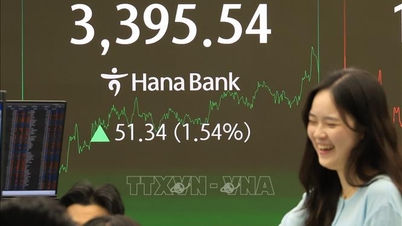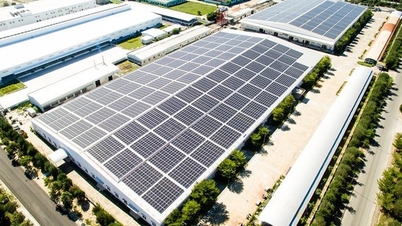Inflation is essentially the same but the US is expected to cut interest rates in September, three months later than Europe due to a stronger economy .
Inflation has been falling from peaks on both sides of the Atlantic, but the pace of decline in the US has slowed recently. The personal consumption expenditures (PCE) index - the Federal Reserve's preferred inflation measure - was 2.7% in March, up 0.2% from 2.5% in February.
Another measure of inflation, the consumer price index (CPI), has also shown a similar upward trend. In March, the CPI increased by 3.5% compared to the same period in 2023.
As a result, Fed policymakers are expected to keep interest rates unchanged next week. Veronica Clark, an economist at Citigroup, said the Fed may not have enough evidence to cut rates after June.
The Fed will keep interest rates in the 5.25-5.5% range from July 2023. They raised the policy rate by 525 basis points from March 2022. US financial markets initially expected the first Fed cut to come in March. That expectation was pushed back to June, then September as data on the labor market and inflation continued to rise.

Consumers shop at a supermarket in Chicago, Illinois on November 22, 2022 Photo: Reuters
Meanwhile, in the 20 countries that use the euro, annual consumer price inflation has slowed steadily since the start of the year and stood at 2.4% last month. With this development, the market predicts that the European Central Bank (ECB) will likely start cutting interest rates in June, three months ahead of the Fed.
An even more unexpected scenario is that policymakers are considering a rate hike. Earlier this month, Fed Governor Michelle Bowman said she would support a rate hike "if inflation slows or reverses."
So is inflation higher in the US than in Europe? In fact, the higher figures are largely due to differences in the way they are calculated. In the US, the PCE and CPI both include an owner-occupied housing cost index, which tracks inflation in the housing market. It includes costs associated with owning and using a home, such as rent, maintenance, and insurance. The weights of this index in the basket are 13% and 32%, respectively.
However, the inflation measure in Europe does not include this, which is 0%. So when removing the assumed housing costs, Simon MacAdam, deputy global economist at Capital Economics, found that core inflation (which excludes energy and food prices) has been “very similar” between the two regions over the past six months.
“Washington does not have a fundamental problem of widespread excessive price pressures, contrary to some recent comments by commentators,” he declared.
If inflation levels are essentially the same on both sides of the Atlantic, why are the Fed and ECB expected to cut interest rates at different times?
The simple answer is the health of the two economies. Carsten Brzeski, global head of macroeconomic research at ING, says “the transatlantic divergence is greater when it comes to economic growth”.
The International Monetary Fund (IMF) forecasts the US to grow 2.7% this year, compared with just 0.8% for the eurozone. Companies here are hiring at a record rate, adding 303,000 jobs in March. Washington has spent more than European governments in recent years to support consumers and businesses through the pandemic, which has led to strong demand.
Treasury Secretary Janet Yellen told Reuters the economy is still “firing full blast,” despite preliminary data this week showing US growth in the first quarter was weaker than expected.
Meanwhile, the European economy is weaker, partly due to the lingering effects of the energy crisis. When the conflict in Ukraine broke out in 2022, gas prices rose to all-time highs. As a result, eurozone CPI and PCE peaked at 10.6% and 7.1%, respectively, in 2022.
The strength of the world’s largest economy makes it more likely that inflation will remain high, according to Brzeski. That’s why the Fed is more hesitant than the ECB to cut interest rates. More broadly, US consumer demand appears to be stronger. Last month, adjusted for inflation, real consumer spending rose 0.5%.
This comes as the household savings rate fell to a 16-month low of 3.2%. However, Michael Pearce, deputy US economist at Oxford Economics, said the low savings were not a major concern, saying it mainly reflected the strong state of household finances.
Brzeski agrees that the decline in US household savings rates means people are willing to spend their savings. Meanwhile, “European households are a little more cautious,” he says.
Davide Oneglia, director of global and European macroeconomics at research firm TS Lombard, agrees. "Americans are more eager to spend because they may see better prospects in the labor market," he said.
Meanwhile, in Europe, the ECB is increasingly confident of cutting interest rates soon. The organization's recently released survey shows that eurozone consumers expect inflation over the next 12 months to be 3%. This is 0.1% lower than the previous survey and also the lowest level since December 2021.
Phien An ( according to CNN, Reuters )
Source link





![[Photo] Students of Binh Minh Primary School enjoy the full moon festival, receiving the joys of childhood](https://vphoto.vietnam.vn/thumb/1200x675/vietnam/resource/IMAGE/2025/10/3/8cf8abef22fe4471be400a818912cb85)
![[Photo] Prime Minister Pham Minh Chinh chairs meeting to deploy overcoming consequences of storm No. 10](https://vphoto.vietnam.vn/thumb/1200x675/vietnam/resource/IMAGE/2025/10/3/544f420dcc844463898fcbef46247d16)

































































































Comment (0)